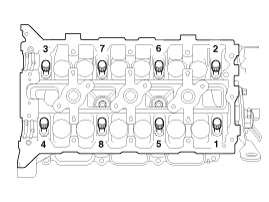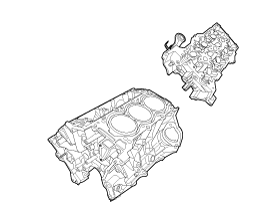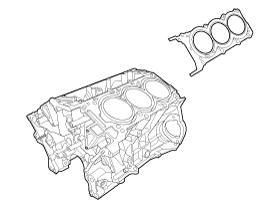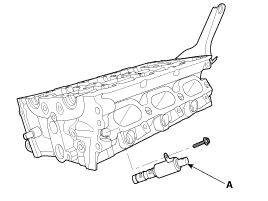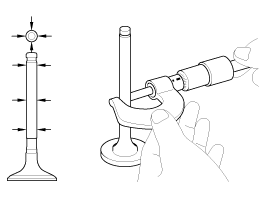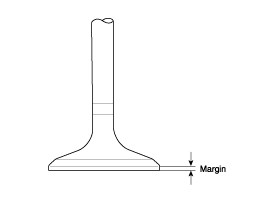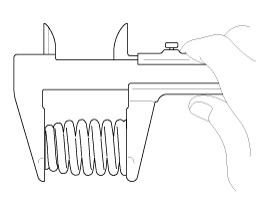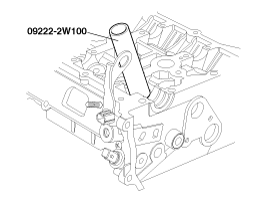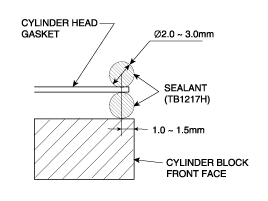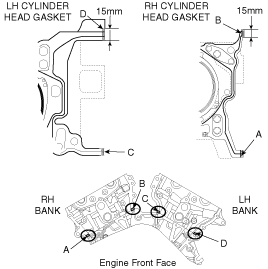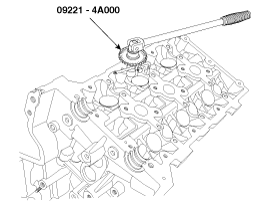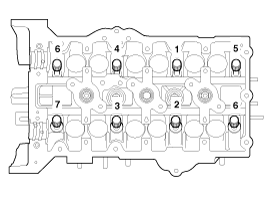Kia Cadenza: Cylinder Head Assembly / Cylinder Head Repair procedures
Kia Cadenza YG 2016-2025 Service Manual / Engine Mechanical System / Cylinder Head Assembly / Cylinder Head Repair procedures
| Removal |
|
|
| [RH] |
| 1. |
Remove the RH camshafts.
(Refer to Cylinder Head Assembly - "Camshaft") |
| 2. |
Remove the water temperature control assembly.
(Refer to Cooling System - "Water Temperature Control Assembly") |
| 3. |
Remove the RH exhaust manifold.
(Refer to Intake And Exhaust System - "Exhaust Manifold") |
| 4. |
Remove the RH cylinder head.
|
| [LH] |
| 1. |
Remove the LH camshafts.
(Refer to Cylinder Head Assembly - "Camshaft") |
| 2. |
Remove the water temperature control assembly.
(Refer to Cooling System - "Water Temperature Control Assembly") |
| 3. |
Remove the LH exhaust manifold.
(Refer to Intake And Exhaust System - "Exhaust Manifold") |
| 4. |
Remove the LH cylinder head.
|
| Disassembly |
Identify MLA, valves and valve springs as they are removed so that each item can be reinstalled in its original position. |
| 1. |
Remove the MLAs (A).
|
| 2. |
Remove the valves.
|
| 3. |
Remove the LH/RH intake camshaft OCV (A).
|
| Inspection |
| Cylinder Head |
| 1. |
Inspect for flatness.
Using a precision straight edge and feeler gauge, measure the surface contacting cylinder block and the manifolds for warpage.
|
| 2. |
Inspect for cracks.
Check the combustion chamber, intake ports, exhaust ports and
cylinder block surface for cracks. If cracked, replace the cylinder
head. |
Valve And Valve Spring
| 1. |
Inspect valve stems and valve guides.
|
| 2. |
Inspect valves.
|
| 3. |
Inspect valve seats
Check the valve seat for evidence of overheating and improper contact with the valve face.
If the valve seat is worn, replace cylinder head.
Before reconditioning the seat, check the valve guide for
wear. If the valve guide is worn, replace cylinder head. Recondition the
valve seat with a valve seat grinder or cutter. The valve seat contact
width should be within specifications and centered on the valve face. |
| 4. |
Inspect valve springs.
|
MLA
| 1. |
Inspect MLAs.
Using a micrometer, measure the MLA outside diameter.
|
| 2. |
Using a caliper gauge, measure MLA tappet bore inner diameter of cylinder head.
|
| 3. |
Subtract MLA outside diameter measurement from tappet bore inside diameter measurement.
|
| Reassembly |
Thoroughly clean all parts to be assembled.
Before installing the parts, apply fresh engine oil to all sliding and rotating surfaces.
Replace oil seals with new ones. |
| 1. |
Install the valves.
|
| 2. |
Install the MLAs.
Check that the MLA rotates smoothly by hand.
|
| 3. |
Install the LH/RH inteke camshaft CVVT OCV(A).
|
| Installation |
|
| [RH] |
| 1. |
Install the cylinder RH head.
|
| 2. |
Install the RH cylinder head bolts.
|
| 3. |
Install the other parts reverse order of removal.
|
| [LH] |
| 1. |
Install the cylinder LH head.
|
| 2. |
Install the LH cylinder head bolts.
|
| 3. |
Install the other parts reverse order of removal.
|
 Cylinder Head Components and Components Location
Cylinder Head Components and Components Location
Components
1. RH Cylinder head2. RH Cylinder head gasket3. LH Cylinder head4. LH Cylinder head gasket5. Cylinder block
1. Camshaft bearing cap 2. Camshaft thrust bearing cap 3. RH Exhaust ca ...
 Cylinder Block
Cylinder Block
...
Other information:
Kia Cadenza YG 2016-2025 Service Manual: CVVT Oil Control Valve (OCV) Specifications
Specification ItemSpecificationCoil Resistance (Ω)9.4 ~ 10.4 [20°C(68°F)] ...
Kia Cadenza YG 2016-2025 Service Manual: Telemetics Unit (TMU) Repair procedures
Removal • Take care not to scratch the crash pad and related parts. 1. Disconnect the negative (-) battery terminal. 2. Remove the AVN monitor. (Refer to "AVN System" - "AVN Head Unit") 3. Remove the TMU unit (A) after loosening the mounting ...
Copyright © www.kcadenzavg.com 2017-2025





